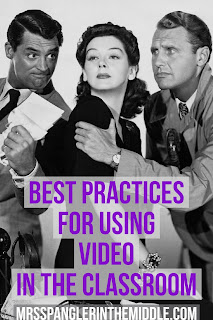If you're like me, you are starting to think about the new school year and the concept of using videos is really appealing because you know that they are super engaging and they allow you to monitor the students even better.
However, you want to make sure that what you are using is educationally sound - that it uses best practices. But what are video best practices? Here's what I've found:
 |
| Source |
Vanderbilt University suggests looking for videos have one or all 4 of these items:
1. Signaling with the appearance of key words
2. Segmenting of information (aka chunking)
3. Weeding - the process of eliminating unnecessary extras like odd sound effects
4. Matching modality - students can see and hear the same concept at the same time.
These four items make a great checklist for anyone when choosing videos for their classes.
And commonsense.org suggests that transcripts can be powerful tools as students can annotate them. They also suggest multiple viewings of the videos so as to explore them from different points of view.
I really like the idea of having transcripts not just forannotation, but also a kind of notes to help students remember what they have seen.
I have tried to incorporate all these things into videos that I make for my own classes. Currently, I have been working on a step-by-step video to teach my students all the pieces and parts of writing a text-based informational essay. You can see a preview of that video by clicking here.
Next up, Argumentative Essays!
Thanks for stopping by!
